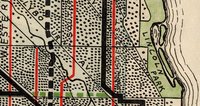
Sheet maps of Chicago from the years between 1900 and the onset of World War I that are held at the University of Chicago Library's Map Collection. The maps portray a city where much that was true of Chicago in the 1890s remained the case. Chicago continued to grow, reaching a population (not counting suburbs) of nearly 2.2 million in 1910, and perhaps 2.4 million in 1914, when (by some measures) it was still the world’s sixth largest city. The expansion of the elevated railroad system also continued in the new century. There were 34.8 miles of line at the beginning of 1900 and 70.3 at the end of 1914, when Chicago's "L" was apparently the third longest metropolitan railway in the world. These rail lines were firmly focused on Chicago's central business district, the Loop, which continued during the first years of the 20th century to acquire an ever more impressive collection of office buildings, department stores, and cultural institutions.
There were some substantial alterations in urban geography during these years . The Sanitary and Ship Canal was finally finished in 1900, and waste began to be sent down toward the Mississippi rather than into Lake Michigan. Three major electric interurban lines, opening one by one in the early years of the 20th century, provided alternative routes to and from the surrounding region. At the same time, the size of factories increased, and much of the new growth in manufacturing was concentrated on the city's South Side (for example, in the Central Manufacturing District) and in the Calumet Region, which extended from the southern part of the city eastward around the southern shore of Lake Michigan. Finally, Chicago's modern street numbering system was established in 1909.
View Online Collection